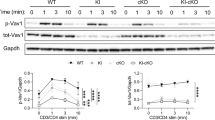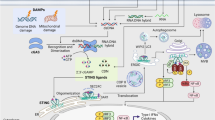Abstract
This review features two areas of our research interests. First, our laboratory is interested in elucidating the molecular mechanisms that control generation, effector function, and fate of TH1 cells during inflammatory responses. We have been particularly interested in the role of the growth arrest and DNA damage-inducible protein 45 (GADD45) gene family in TH1-mediated immune responses. We and others have shown that, in TH1 cells, Gadd45b and Gadd45g are induced by TCR signaling or IL-12 and IL-18. Gadd45b and Gadd45g are very important for the activation of p38 MAP kinases in TH1 cells and for effector functions of TH1 cells. We have found that deletion of Gadd45b and Gadd45g genes in mice results in a drastically reduced number of TH1 cells against Listeria monocytogenes. The critical role of Gadd45b and Gadd45g in TH1 responses in this acute infectious model has led us to hypothesize that they promote TH1-mediated autoimmune diseases. We therefore decided to test this hypothesis in experimental allergic encephalomyelitis (EAE), a mouse model of multiple sclerosis (MS). Expecting low numbers of TH1 cells, we were surprised to see that Gadd45b deletion resulted in exacerbated chronic phase of EAE. In contrast to the reduction of TH1 cells we saw in acute L. monocytogenes infection, during the chronic phase of EAE we observed increased TH1 cells in the inflamed CNS when Gadd45b was deleted. Gadd45b deletion also resulted in enlarged spleens in older mice. Gadd45b/Gadd45g double-deficiency further aggravated this phenotype and resulted in greatly enlarged spleens in older mice compared with Gadd45b single deletion. The enlargement of spleens was due to the accumulation of CD4+ T cells with an activated phenotype and B cells. In addition, we have found that Gadd45b and Gadd45g inhibit proliferation and promote apoptosis of activated CD4+ T cells. Therefore, Gadd45b and Gadd45g play a critical role as a molecular “double-edged sword” in TH1-type immune responses to ensure a prompt, robust but self-limiting TH1 response. The second area of research in our laboratory focuses on the role of autophagy in T cells. We have recently discovered that autophagy is induced in TH1 and TH2 cells. There are more effector TH2 cells than TH1 cells that undergo autophagy. We have used RNAi strategy to “knockdown” autophagy in TH2 cell lines and found that autophagy is required for growth factor-withdrawal cell death.
Similar content being viewed by others
References
Hsieh CS, Macatonia SE, Tripp CS, Wolf SF, O'Garra A, Murphy KM: Development of TH1 CD4+ T cells through IL-12 produced by Listeria-induced macrophages. Science 1993;260:547–549.
Lu B, Zagouras P, Fischer JE, Lu J, Li B, Flavell RA: Kinetic analysis of genomewide gene expression reveals molecule circuitries that control T cell activation and TH1/2 differentiation. Proc Natl Acad Sci USA 2004;101:3023–3028.
Szabo SJ, Dighe AS, Gubler U, Murphy KM: Regulation of the interleukin (IL)-12R beta 2 subunit expression in developing T helper 1 (Th1) and Th2 cells. J Exp Med 1997;185:817–824.
Lu B, Yu H, Chow C, et al: GADD45gamma mediates the activation of the p38 and JNK MAP kinase pathways and cytokine production in effector TH1 cells. Immunity 2001;14:583–590.
Lu B, Ferrandino AF, Flavell RA: Gadd45beta is important for perpetuating cognate and inflammatory signals in T cells. Nat Immunol 2004;5:38–44.
Liu L, Tran E, Zhao Y, Huang Y, Flavell R, Lu B: Gadd45 beta and Gadd45 gamma are critical for regulating autoimmunity. J Exp Med 2005;202:1341–1347.
Rogge L, Bianchi E, Biffi M, et al: Transcript imaging of the development of human T helper cells using oligonucleotide arrays. Nat Genet 2000;25:96–101.
Dong C, Davis RJ, Flavell RA: MAP kinases in the immune response. Annu Rev Immunol 2002;20:55–72.
Rincon M, Enslen H, Raingeaud J, et al: Interferon-gamma expression by Th1. effector T cells mediated by the p38 MAP kinase signaling pathway. EMBO J 1998;17:2817–2829.
Hubank M, Schatz DG. Identifying differences in mRNA expression by representational difference analysis of cDNA. Nucleic Acids Res 1994;22:5640–5648.
Zheng W, Flavell RA: The transcription factor GATA-3 is necessary and sufficient for Th2 cytokine gene expression in CD4 T cells. Cell 1997;89:587–596.
Li B, Yu H, Zheng W, et al: Role of the guanosine triphosphatase Rac2 in T helper 1 cell differentiation. Science 2000;288:2219–2222.
Takekawa M, Saito H: A family of stress-inducible GADD45-like proteins mediate activation of the stress-responsive MTK1/MEKK4 MAPKKK. Cell 1998;95:521–530.
Yang J, Zhu H, Murphy TL, Ouyang W, Murphy KM: IL-18-stimulated GADD45 beta required in cytokine-induced, but not TCR-induced. IFN-gamma production. Nat Immunol 2001;2:157–164.
Lu HT, Yang DD, Wysk M, et al: Defective IL-12 production in mitogen-activated protein (MAP) kinase kinase 3 (Mkk3)-deficient mice. EMBO J 1999;18:1845–1857.
Kearsey JM, Coates PJ, Prescott AR, Warbrick E, Hall PA: Gadd45 is a nuclear cell cycle regulated protein which interacts with p21Cip1. Oncogene 1995;11:1675–1683.
Wang XW, Zhan Q, Coursen JD, et al: GADD45 induction of a G2/M cell cycle checkpoint. Proc Natl Acad Sci USA 1999;96:3706–3711.
Bulavin DV, Higashimoto Y, Popoff IJ, et al: Initiation of a G2/M checkpoint after ultraviolet radiation requires p38 kinase. Nature 2001;411:102–107.
Tsujimoto Y, Shimizu S: Another way to die: autophagic programmed cell death. Cell Death Differ 2005:12(Suppl 2):1528–1534.
Kuida K, Haydar TF, Kuan CY, et al: Reduced apoptosis and cytochrome c-mediated caspase activation in mice lacking caspase 9. Cell 1998;94:325–337.
Ohsumi Y: Molecular dissection of autophagy: two ubiquitin-like systems. Nat Rev Mol Cell Biol 2001;2:211–216.
Levine B, Klionsky DJ: Development by self-digestion: molecular mechanisms and biological functions of autophagy. Dev Cell 2004;6:463–477.
Kuma A, Hatano M, Matsui M, et al: The role of autophagy during the early neonatal starvation period. Nature 2004;432:1032–1036.
Kamada Y, Sekito T, Ohsumi Y: Autophagy in yeast: a TOR-mediated response to nutrient starvation. Curr Top Microbiol Immunol 2004;279:73–84.
Priault M, Salin B, Schaeffer J, Vallette FM, di Rago JP, Martinou JC: Impairing the bioenergetic status and the biogenesis of mitochondria triggers mitophagy in yeast. Cell Death Differ 2005;10:10.
Elmore SP, Qian T, Grissom SF, Lemasters JJ: The mitochondrial permeability transition initiates autophagy in rat hepatocytes. FASEB J 2001;15:2286–2287.
Ogawa M, Yoshimori T, Suzuki T, Sagara H, Mizushima N, Sasakawa C: Escape of intracellular Shigella from autophagy. Science 2005;307:727–731.
Nakagawa I, Amano A, Mizushima N, et al: Autophagy defends cells against invading group A Streptococcus. Science 2004;306:1037–1040.
Deretic V: Autophagy in innate and adaptive immunity. Trends Immunol 2005;11:11.
Clarke PG: Developmental cell death: morphological diversity and multiple mechanisms. Anat Embryol (Berl) 1990;181:195–213.
Gozuacik D, Kimchi A: Autophagy as a cell death and tumor suppressor mechanism. Oncogene 2004;23:2891–2906.
Salvador JM, Hollander MC, Nguyen AT, et al: Mice lacking the p53-effector gene Gadd45a develop a lupus-like syndrome. Immunity 2002;16:499–508.
Author information
Authors and Affiliations
Rights and permissions
About this article
Cite this article
Lu, B. The molecular mechanisms that control function and death of effector CD4+ T cells. Immunol Res 36, 275–282 (2006). https://doi.org/10.1385/IR:36:1:275
Issue Date:
DOI: https://doi.org/10.1385/IR:36:1:275




